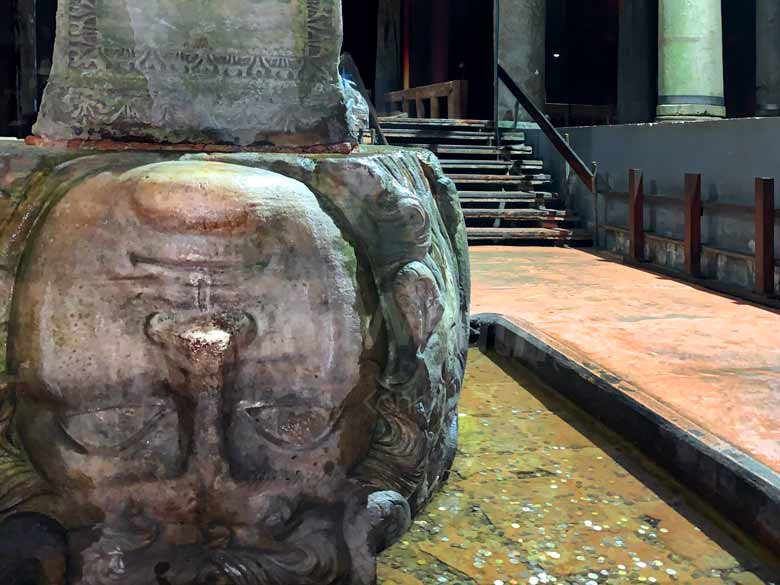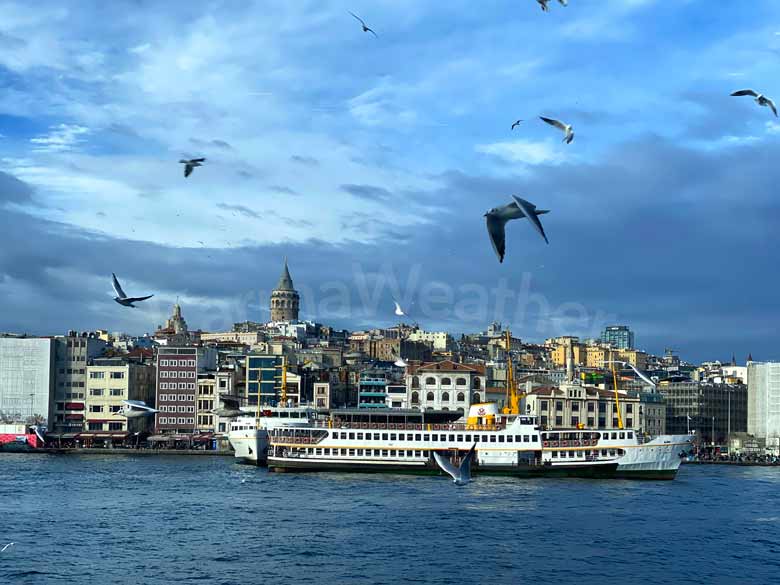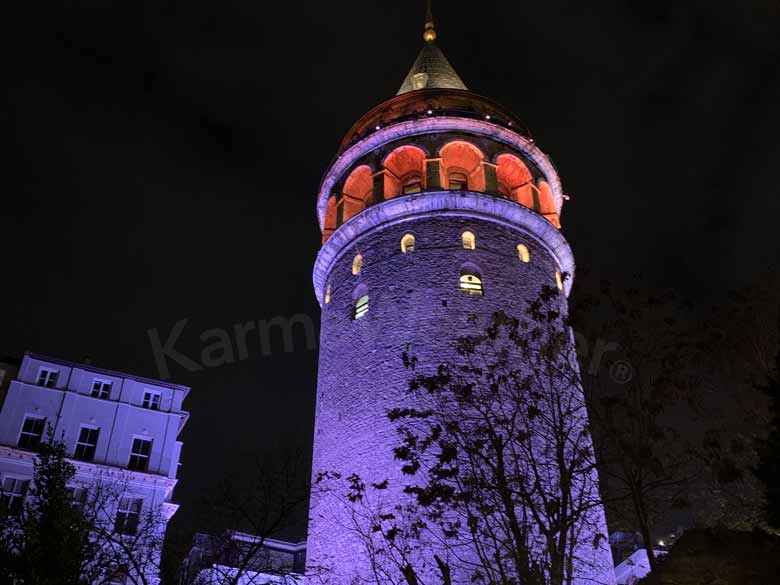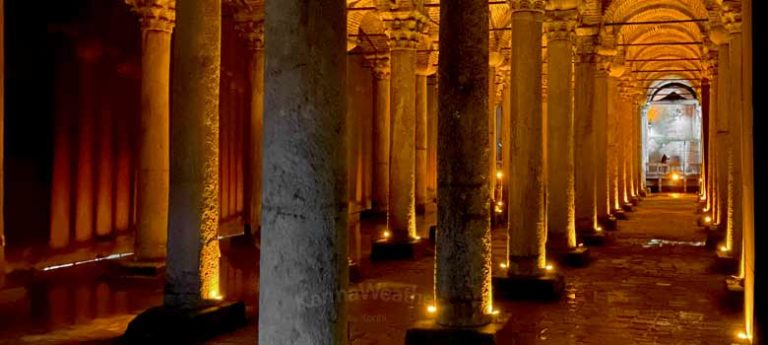The buried mysteries of Istanbul's Basilica Cistern
© KarmaWeather by Konbi - All rights reserved
History of the Basilica Cistern
Introduction
Istanbul, a place rich in secrets and wonders, harbors in its bowels a real treasure of Byzantine history: the Basilica Cistern. Designed during the reign of Constantine 1st and remodeled by Emperor Justinian 1st after the revolts of Nika in 532, this majestic construction offers a journey through time and a breathtaking spectacle. Embedded in the ground of the Sarayburnu peninsula, it rubs shoulders with illustrious neighbors such as the Hagia Sophia and Topkapi Palace. This underground structure is today a major place to visit, testifying to the glorious past of the city. It is said that more than 7000 slaves were used to erect this imposing structure.
Origin of the name
The Basilica Cistern finds its origin in the historic city of Istanbul, precisely on the Sarayburnu peninsula. Formerly, the site was occupied by a Roman public square vibrating to the rhythm of commercial, artistic and judicial exchanges. At the heart of it, a basilica stood between the 3rd and 4th centuries, a place that breathed the life of the city. The foundations of this civil basilica, with its central nave flanked by two side aisles, served as a model for the structure of the cistern.
Rediscovery
During the sixteenth century, Dutch explorer Petrus Gyllius embarked on a journey that would reveal a long-forgotten marvel in the heart of the Orient, the Basilica Cistern of Istanbul. In 1545, while following the ancient road to Byzantium, he heard of a strange possibility: fishing and drawing water from the basements of some houses near the famous Hagia Sophia. Intrigued by this enigma, Gyllius embarked on a quest that led him, torch in hand, to descend an ancient stone staircase in the backyard of a modest wooden dwelling.
Previously, during the Byzantine era, this cistern played a crucial role in supplying water to the grand palace and the residents of the surrounding area, including the emperor himself. However, after the capture of Istanbul in 1453, although the cistern continued to serve for some time supplying water to Topkapi Palace, the residence of the sultans, it was gradually abandoned. The Ottomans, favoring running water, developed their own water systems, leaving the cistern to sink into oblivion.
Embracing his curiosity, Gyllius made his way into the cistern, his path lit by the flickering light of his torch. Guided by local tales of water-drawing and fishing inside their homes, he was the first to navigate through the vast expanse underground, identifying the columns and measuring the dimensions. Sharing his findings in his travel book, Gyllius brought this Byzantine relic back to life, and the Basilica Cistern was once again introduced to the Western world.

Construction
Emperor Justinian, with the help of thousands of slaves, created an underground masterpiece following the Nika Riots that ravaged the city in 532. This magnificent place, known as the Basilica Cistern, was built in the basement of a grandiose structure, the Basilikè, which had unfortunately been burned down during the said riots.
Ancient chronicles tell us that the Emperor Constantine had already erected a building on this spot, embellished with gardens, a colonnade and offering a view of the Hagia Sophia. It was this original structure that Justinian chose to rebuild and expand, digging deep to form a vast reservoir capable of accommodating excess water from rainy seasons.
The primary role of this cistern was to meet the water needs of the Great Palace of Constantinople and the other buildings located on the first hill. Even after the Ottoman conquest of the city in 1453, and the transformation of the Grand Palace into Topkapi Palace, the cistern continued to serve. However, the Ottomans, preferring running water to stagnant water, gradually abandoned this system, which led to the abandonment of the cistern.
Facts and practical information about the Basilica Cistern
The Basilica Cistern is an architectural feat. It covers an area of 9800 square meters and can hold up to 80,000 cubic meters of water. It is reached by a narrow staircase of 52 steps which leads to an underground space bordered by a forest of 336 marble columns, 9 meters high. These columns, mostly in the Ionic and Corinthian style, are arranged in 12 rows of 28 columns.
Certain columns are engraved with symbolic reliefs, such as a column decorated with an eye, branches and tears, in homage to the slaves who perished during the construction of the cistern. Finally, the water for the cistern came from the Belgrade forest, located 19 kilometers north of the city.
The Basilica Cistern in popular culture and legends
The Basilica Cistern, with its mysterious atmosphere and unique aesthetic, has inspired many legends. The murmur of the water, the subdued light dancing on the marble columns, everything contributes to creating a feeling of strangeness and fascination. The columns of the cistern are said to have been salvaged from ruins in various parts of the empire, giving the cistern a motley look and a tangible connection to the history of the Byzantine Empire.
Among them, two columns perched on the heads of Medusa inevitably attract attention in the northwest corner of the Basilica Cistern. These faces of the mythological creature, enigmatic and shrouded in mystery, are the work of artisans from Roman times. The origin of these carved blocks remains a subject of conjecture, as does the building from which they were dislodged. While some scholars believe they were simply used to support the columns when the cistern was built, many legends surround these Medusa heads.
Among the competing theories, some hold that these heads come from the Forum of Constantine, the place where other similar faces have been discovered. The unusual arrangement of these heads, one placed laterally and the other totally inverted, has given rise to several interpretations. Some see it as evidence of the pragmatism of Byzantine builders who reused Roman ruins. Others see it as a bold manifestation of the Christian faith, a symbolic way of denying pagan deities. Yet another theory suggests that this arrangement was intended to nullify the mythical power of the Gorgon's gaze.
Beyond the mysteries of Medusa, another column, nicknamed the "Weeping Column", also commands attention. This column stands in memory of the slaves who lost their lives during the construction of this underground monument.
Plan a trip to Istanbul
Istanbul, where the paths of history and the waves of modernity intertwine, is an invitation to explore. This vibrant city at the confluence of two continents, Europe and Asia, charms its visitors with its picturesque landscapes, its fascinating architectural heritage and its infinite cultural treasures. Preparing for a trip to Istanbul means promising yourself a trip to a world where ancestral traditions rub shoulders with contemporary effervescence, where each dish savored tells a story and each encounter is marked by warm hospitality.

The Blue Mosque, with its six soaring minarets and cascading domes, offers a stunning visual spectacle, while its interior decoration, richly adorned with Iznik ceramic tiles, is simply stunning. Nearby, Hagia Sophia, once a Byzantine cathedral, then a mosque and now a museum, offers a glimpse into the complex past of this unique city.
Topkapi Palace, former residence of the Ottoman sultans, is a journey through the centuries, a testimony to the greatness of the Ottoman Empire. Each room reveals priceless treasures, while the gardens offer panoramic views of the Bosphorus, that shimmering ribbon of water that defines Istanbul.
But Istanbul is not just about its glorious past. It is a dynamic metropolis that beats to the rhythm of modernity. From designer boutiques to avant-garde art galleries, from gourmet restaurants to trendy cafes, each neighborhood has its own personality. Let yourself be carried away by the intoxicating scents of the spice market and succumb to the charms of the Galata district, with its famous tower and picturesque streets.

Turkey's Chinese zodiac animal sign and compatibility
Find out how compatible you are with the country you plan to visit
|
